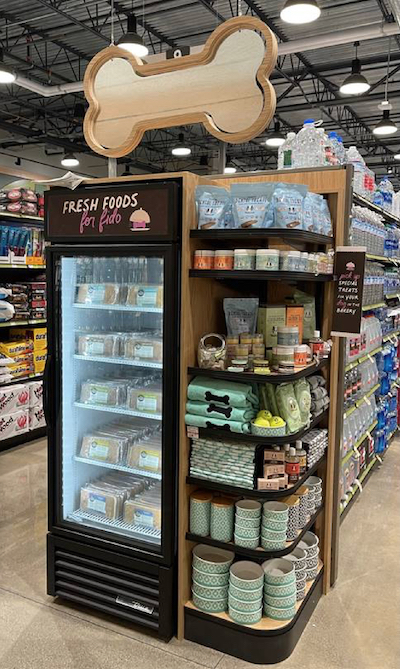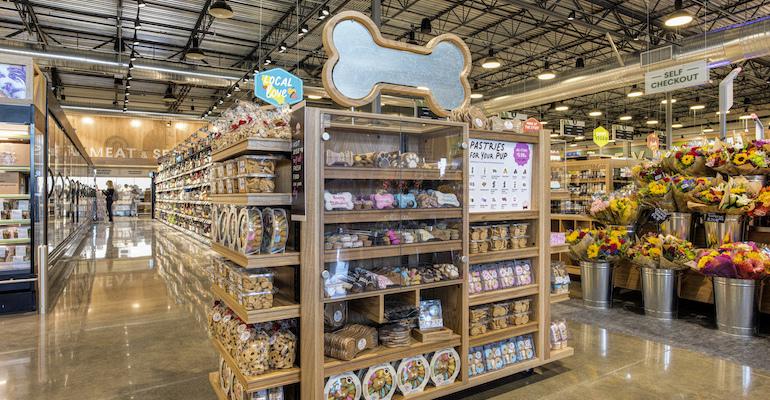TOP TAKEAWAYS
- Across all retail outlets, sales of dog food and treats were up 12.2% over a year ago, while sales of cat food and treats grew 14.6%
- The “humanization” of pet food — i.e. owners seeking more human-style foods for their pets — has continued to drive innovation and sales gains in the category
- Fresh and frozen pet foods have seen the highest percentage growth year over year in the overall pet category
The “premiumization” of pet food continues to drive sales at supermarkets amid inflationary pressures, ongoing supply chain issues, and the growth of e-commerce sales.
Momentum has stayed strong from the surge in pet adoption during the pandemic that boosted the category, said Shep Kroner, director of customer insight for UNFI Brands+, the private-label division of Providence, R.I.-based distributor United Natural Foods Inc.
Across all retail outlets, sales of dog food and treats were up 12.2% over a year ago, while sales of cat food and treats grew 14.6%, according to NielsenIQ data he cited for the 52 weeks ended July 23.
The gains primarily came from rising prices, Kroner noted.
“Inflation has had a major impact on the category,” said Kroner, noting average unit-price increases of 14% for dog food and treats and 15.5% for cat food and treats in the past year.
Jeff Tawson, category manager at Western grocer Raley’s, agreed that dollar sales remain at all-time highs in the category, although unit volumes “remain a major concern in both cat and dog segments.” He said pet food brands have been raising prices anywhere from 7% to 17%, and some have passed along multiple increases during the past 12 months.
Supply chain shortfalls also remain a challenge, especially for value-priced brands, where fill rates have been “well below 60%,” Tawson said. Wet cat food also continues to experience supply chain challenges, according to UNFI’s Kroner.
“If pet parents wanted to switch to a more economical brand, would they be able to?” Tawson said.
Barbara Connors, vice president of commercial insights at Cincinnati-based data research firm 84.51°, a Kroger Co. subsidiary, said pet owners are reluctant to trade down or switch brands, even in the face of rising prices.
While 52% of consumers in a recent 84.51° survey said they are cutting back on non-essentials as a result of inflation, only 7% said they are doing so with pet food, Connors reported.
In addition, 46% of consumers said they are switching to lower-cost brands more often overall, but just 20% of respondents are willing to switch to lower-cost brands in pet food. The only category with a lower percentage of consumers willing to switch was baby care, where 10% of consumers said they would buy a lower-priced brand.
“We don’t want to cut back on feeding our two-legged or our four-legged babies,” said Connors.
Sales data from 84.51° show that dry dog food and dry cat food have been the most stable subcategories in terms of sales. But consumers are purchasing some pet supplies less frequently, and some consumers are trading down in treats and accessories.
“Dog treats is the space where we are seeing the highest customer behavior around deal-seeking,” Connors said, adding that private-label treats also have been gaining share of sales this year.
Fresh and frozen pet foods grow
The “humanization” of pet food — i.e. owners seeking more human-style foods for their pets — has continued to drive innovation and sales gains in the category, Raley’s Tawson noted.
“I would say the trend began prior to the onset of COVID, although 2020 and 2021 accelerated the emotional bonds between pet and pet parent,” he explained. “Premium and super-premium pet food and treats appeared to have no ceiling.”
Fresh and frozen premium brands are still growing, Tawson said. West Sacramento, Calif.-based Raley’s is continuing to expand its relationship with Freshpet, a maker of refrigerated pet food, and the retailer has also added frozen, human-grade pet foods at its O-N-E Market locations.
“We have three stores where we will be able to test and learn with ingredients, packaging, size and price points,” according to Tawson.
Connors said sales data from 84.51° show that fresh and frozen pet foods have seen the highest percentage growth year over year in the overall pet category, although it remains a small portion of total category volume.
In addition to adding more refrigerated and frozen pet foods, Raley’s is expanding a new kiosk displaying human-grade baked dog treats to more locations.
UNFI, meanwhile, has seen rising demand for premium, all-natural pet foods, including its Wild Harvest private label, Kroner said, adding that cat and dog food items have been the fastest-growing categories for the brand in the past year.
Bryan Jaffe, an analyst at Cascadia Capital, said the trend toward the humanization of pet food bodes well for the supermarket channel.
“We’re seeing increased incidence of human-pet corollaries, which lends itself well to grocery distribution,” Jaffe said. “You buy jerky for yourself, you buy jerky for your dog. You buy cookies for yourself, you buy cookies for your dog.”
Raley's Roseville O-N-E Market offers fresh, human-grade pet food and specialty dog treats.
Raley’s expands baked-treats kiosk for pets
Western grocer Raley’s has rolled out a new baked-goods display for dog treats in its O-N-E Market stores and is expanding them to traditional Raley’s supermarkets.
“Our goal was really to create a destination that meets and exceeds all of our customers’ dog treat needs,” said Kristina Garris, director of food services at West Sacramento, Calif.-based Raley’s.
The display on the dog pastry/treat kiosk includes four categories of human-grade treats: retail packages of treats from Claudia’s Canine Bakery; bulk dog biscuits and cookies; specialty dog “pastries” designed to be aesthetically pleasing to both humans and dogs and made to look like items in a typical human bakery; and happy birthday/gotcha day (the anniversary of a pet’s adoption) dog cakes and cupcakes for special occasions.
“Our idea was to create a dog pastry/treat kiosk that could be cross merchandised in the bakery department, near our human pastry and doughnut case, so that customers could include canine family members in an occasional indulgent treat with the rest of the family,” Garris said.
Besides promoting the kiosk with specials in its traditional print ads, Raley’s is promoting the program via e-commerce platform and paid social media, she added.
“Customer reaction has been overwhelmingly positive, and the program is really out-pacing initial sales projections,” Garris said. “We’re seeing a lot of great organic social media posts, and it’s one of our most-mentioned new programs.”
Because of the initial success, Raley’s is launching the program in all four of its natural/organic O-N-E Market stores, as well as Raley’s stores in Incline Village, Nev., and the banner’s newly remodeled Bel Air store in Sacramento, Calif.
“As we learn in these locations, we’ll decide on additional expansion opportunities,” Garris said.





